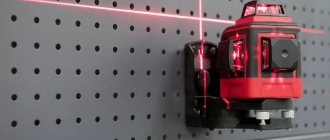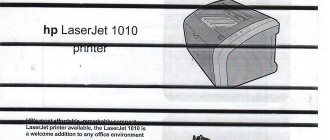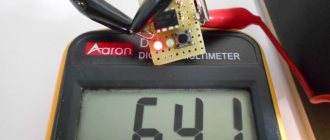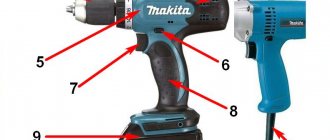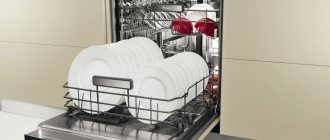Device of laser and optical levels
Levels are a budget type of equipment that is often used by craftsmen. They are quite accurate and reliable when working in different conditions.
The main component of the optical device is a telescope, which magnifies 20 times PHOTO: remoskop.ru
The device is equipped with a cylindrical level for horizontal alignment and an elevation screw for orientation in space. Before use, the level must be mounted on a tripod and leveled using lifting screws. The integrated bubble level will help you determine the correct position. The telescope is aimed at the installed staff using the sighting device and adjusted for sharpness by rotating the eyepiece ring.
Laser products have recently been replacing optical analogues, attracting buyers with their comfort, compact size, simple use and great functionality.
The devices make it possible to take fairly accurate measurements, as well as build straight lines in several planes at the same time. Laser levels are more focused on repair and construction work indoors; household appliances rarely cast a beam with a range of more than 30 m.
Using a laser level: additional features
In addition to the functions presented above, the laser level allows you to mark on almost any plane. In order to draw inclined lines, you can use a mechanism with an angle scale. A few decades ago, many such problems were solved using a regular building level or simply “by eye,” but with the advent of such a tool, everything changed. It is quite simple to master all the features of a laser level, and the capabilities of such a modern device allow you to easily cope with a whole range of construction work, doing everything quickly, efficiently and without much effort.
Step-by-step photo instructions for leveling with an optical device
To properly install and configure an optical level, we will need: the level itself, a tripod and a measuring rod.
How to set up a tripod
The main task when installing a tripod is to maintain the correct horizontal base.
| Illustration | Description of action |
| We take out the tripod, fold back the clips, and extend the tripod legs to the height we need. Each of the three legs, thanks to special sliding sliders, extends and is tightly fixed at the required height, and the difference can be either significant or insignificant. We fix the height by clamping the clips. | |
| In order for the tripod to be fixed as rigidly as possible in the ground, we need to press a special footrest with our foot. | |
| We take the level out of the box, place it on a tripod and fix it to the base using a special fastening screw. |
This design allows you to install the level on a tripod evenly, firmly and steadily even on a bumpy surface.
Installation and adjustment of the level
Illustration Description of action
To level the level, we rotate it so that two lifting screws are to the right and left of the device, and the third is located on the front of it.
By rotating the two side screws in opposite directions, we ensure that the air “bubble” is located on the central axis of the level mark.
Now we begin to rotate the screw located on the front of the level and move the air bubble already in the vertical level of the device
When setting up each subsequent bubble level, pay attention to how the previous one behaves.
Setting the device focus
Before you start working with the device, you must correctly focus the optics. Each person adjusts it to their own vision. The stages are as follows:
| Illustration | Description of action |
| We ask your partner to stand with the staff on the first measured point. When taking measurements, the staff must be kept strictly vertical. To do this, we focus on the bubble level that comes with the level. | |
| And now, using the collimator, which is located in the upper part of the level, we aim at it. |
Measuring and recording values
When the device is installed accurately enough, focused and level, you can proceed to measuring data and recording it.
| Illustration | Description of action |
| We adjust the level until we can clearly see the checkers. We look at where the horizontal strip of threads is depicted on the rail. This is our first countdown on the staff. | |
| We record the data. | |
| After this, we measure the next point according to the same principle as the first. We record data and compare indicators. Thus, we know exactly which point is higher and which is lower and by how much. |
What is the correct position for a laser level?
It is critically important to place the level in the correct position! The quality of his work will depend on this. You can do this as follows.
- The most banal, but important rule is that there should be no objects in the path of reflection of laser beams that will interfere and break the lines. It is necessary to position the level in accordance with the maximum value specified in the instructions. It is not advisable to exceed this maximum, as this makes the marking inaccurate. Reducing the distance, on the contrary, will help increase the accuracy of marking.
- If you need to place the level at a far distance from the walls, then you can use beam receivers that increase the radius of the device. Before carrying out work, it is necessary to fix the level on a plane or on a special holder (a tripod is also suitable).
- You must NOT touch or wobble it if you want to get accurate results. For safety reasons, you should warn people living with you not to enter the room where the relevant work is being carried out, since laser beams can seriously injure the eyes. Pets should also be taken to another room or apartment.
- And the last point: using a bubble level (which is built into your device), you need to level the device horizontally. While the device is moving, the bubble level will make sounds. We need to level our device to meet our needs and leave it motionless, while the sound should subside. If the sound disappears, then we can get to work.
How to work with a laser level: videos and types
There are several types of levels, and each one works a little differently. Static building levels - crossliners or multi-prism builders - are the most common type of device; they are used for small or medium-sized work, and are capable of projecting both intersecting lines and highlighting certain points - a plumb line or zenith.
Rotary line builders – level or multi-prism devices. The principle of operation is that they show both horizontal and vertical planes, so they can indicate lines along the entire perimeter of the room. This is the most expensive device and is used for large-scale construction as well as landscaping. Pros – 360-degree projection capability, long beam range, self-leveling function, low error
There are practically no disadvantages in modern models, the only thing is that you need to work with it carefully, wear special safety glasses and make sure that the beam does not get into the eyes of animals or people
Laser levels may differ in functionality, shape and price
Static axis builders - point lasers or pointers - are the simplest version of the device; it is capable of projecting only one point on any plane; it is most often used for domestic purposes - for wallpapering, placing shelves or paintings. The advantage of this instrument is its high beam range – up to 30 meters. Among the disadvantages - if you need to do a large amount of work and measure many surfaces, then it will need to be constantly turned in the required direction, a high percentage of error is also possible - even a slight deviation can make the parameters incorrect and all markings will be carried out with an error.
Each device must be accompanied by detailed instructions, which indicate the stages of assembling the tool, what is included in its package and how to bring it into working position.
You should also read the safety precautions carefully to avoid an accident.
If the device has a battery, it must be properly and fully charged, and if batteries are installed, it must be installed. Then you need to check the serviceability of the level by turning it on - the appearance of a beam indicates its normal operation.
Experts give a number of tips to help avoid mistakes when working with a laser level:
- There should be no foreign objects on the beam barrier after installation, otherwise the line will be bent.
- The most optimal distance must be used; it is individual for each type of device, so you must follow the attached instructions. If you reduce the distance, the indicator will be more accurate, but to work at a long distance you need to use a special beam receiver, which is included in the kit or purchased separately.
- When working with a level, it must be placed on a flat surface or a tripod. The laser must not oscillate, because then the data will be inaccurate and will need to be reset.
- For precise leveling of the device, some models have a built-in horizontal bubble level with which it is installed, and in more expensive laser levels, a signal is given if it stops, then an accurate check and installation has occurred, it is ready for use.
- When working with the device, it is necessary to warn people and remove animals from the repair site, because the laser beam entering the eyes can cause injury to the retina.
If all recommendations are followed, you can use the device; the data will be accurate and will significantly facilitate all construction work.
How to bring the device into working position?
Before work is carried out, the device is installed in the working position, fixed, and then adjusted.
The device has several modes:
- building horizontal lines;
- projection of vertical lines;
- cross construction mode. The vertical and horizon lines intersect to form an angle of 90 degrees;
- point projection mode.
Setting the level
The plastic, rubber-coated body of the device can be installed on any surface. Rigid fixation of the device is the main principle of fastening.
Important! During operation, vibrations of the device are not allowed; if it shifts, the results will be distorted.
To install the laser level use:
- smooth horizontal surfaces at hand: chairs, window sills, tables;
- Mounting with a tripod to the wall, rods and tripods.
Wall mounts hold the tool with suction cups or magnets, Velcro . The tripod allows you to lift the device up, the rod is convenient for marking the ceiling. Accessories are included in the kit upon purchase or purchased separately as needed.
Settings
Preparing the device for operation consists of setting the level strictly horizontally , it will depend on the type of laser level, and does not require professional skills.
We recommend: The principle of operation and assembly of a manual router. Types of cutters and how to work on wood with your own hands?
Plug-and-play tools will be ready automatically. Adjustment occurs in the range of 5-10 degrees.
When adjusting the working position, the device emits a sound or light signal.
When turned on, the laser level will project the desired beam according to the set measurement mode.
A bright luminous line, one or more, a dot, a cross will appear on the surface.
When moving the device, the adjustment is always made again !
The laser level is manually adjusted by aligning the bubble in the viewing window of the device to the central position . The position is adjusted using screws located on the housing.
Precautionary measures
Safety precautions for working with the device include protecting your eyesight . Direct exposure of the beam to unprotected eyes can cause various damages and diseases, including retinal detachment.
When working, be sure to use special glasses , avoid the beam hitting those present, and isolate pets.
Safety glasses improve the visibility of lines in sunny weather.
How to check a laser level for accuracy
To be able to unconditionally rely on the readings of the laser level, it must be checked. The technical characteristics of the model indicate the maximum permissible error for this device. It is indicated in mm/m (millimeters per meter)
Naturally, the smaller it is, the better, and this is one of the key parameters that are worth paying attention to. But even when comparing different devices of the same model, you can see a significant difference in readings
For a normal repair result, the deviation should be minimal, and it can be determined by inspection. In theory, this check should be done before purchasing, but few stores will give you this opportunity. Then you can check the laser level at home, and if it does not pass the test, return it or exchange it (don’t lose the receipt). The verification procedure itself is in the video. There are quite a lot of manipulations, but they are not complicated.
Additional options and features
In addition to the main parameters, there are also some additional ones. They make things easier, so it's more about usability. After all, additional functions affect the final result only indirectly or partially.
Self-leveling
In order for the measurements to be correct, the level must be installed vertically upward. In simple models, their position is checked with simpler devices, usually a bubble level. In some models it is built into the body, in others it is not. Then you have to resort to ordinary construction, which is not entirely convenient. In addition, incorrect readings are possible - if during operation it changes position and you do not see it, the work will be performed incorrectly. To avoid such a situation, you have to double-check the position of the device several times.
Self-leveling (self-compensation of a small angle of inclination)
Some laser levels have a self-leveling or self-leveling feature. When deviating from the vertical by a small angle (usually up to 4°), they adjust the position of the mirrors and prisms so that all readings are correct. If the tilt exceeds the maximum permissible, they either make a sound/give a light signal, or turn off the beams. Operation is restored when returning to normal.
Having a laser level with this function makes it easy to set up the device at the very beginning of work. Also, during its use, you don’t have to worry that it has changed position - it will give a signal.
However, sometimes the level needs to be set at a certain angle. The presence of a self-leveling function will not allow this to be done. Therefore, it is advisable to purchase a model in which this function can be blocked.
Self-shutdown
This function allows you to save battery power. If the device does not move for 10-15 minutes, it turns off. On the one hand, this is useful, on the other hand, some jobs require more than 15 minutes and shutting down can be annoying. Whether you need this feature or not is up to you.
Automatic shutdown is not always good
Operating temperature
If you plan to work in the warm season or only indoors, the temperature does not matter. Basically, a laser level can be operated at temperatures from +5°C to +40°C, that is, they are only suitable for heated rooms or work in the warm season.
Most laser levels are designed to work in a heated room
If you need to choose a laser level for working outdoors with the possibility of operation in the cold season, there are “frost-resistant” models that can withstand temperatures down to -10°C. Even more frost-resistant ones must be looked for specifically; there are very few of them.
Mounting type
In addition to the standard installation of the laser level on a horizontal plane, there may be several additional options for mounting it:
- On a special tripod. Most often needed for outdoor work, but some work (drawing horizontal lines on walls when hanging furniture, for example) is also easier to do with a tripod. A tripod is sometimes included, sometimes purchased separately. When purchasing, pay attention to the diameter of the thread on the body of the level - the tripod must have the same one.
- On magnets. Some models have magnets soldered into the body. This makes it possible to attach it to any metal surface/part. The type of fastening affects ease of use
- On a special magnetic stand. Some models of laser levels come with a small plastic pad into which magnets are soldered. A platform is installed on a metal surface, and a level is placed on it.
- Self-tapping screw/nail. A special hole is made in the body of the level into which the head of a nail or self-tapping screw is threaded. Not the most convenient way of fastening, but still.
Everything is clear with these options. You can, of course, do without them, come up with your own way. These are simply opportunities for more comfortable operation.
What else you need to pay attention to is how close you can install the level to the vertical plane. The closer the beam can be located to the wall, the easier it is to level the surface of the wall, mark niches in the wall, etc. This depends on the design of the case - the slots for the rays to exit should either be level with the edge of the case, or even slightly moved beyond it.
Shockproof housing and the possibility of self-adjustment (adjustment)
It is very useful if the laser level has a shockproof housing. Construction or repair is a high-risk area for any tool, so it often falls. If the case is shockproof, there is a high probability that even after a fall it will survive.
A shockproof case wouldn't hurt
If dropped or carelessly transported, the level's settings may be lost and it may begin to lie. To eliminate this “phenomenon”, some devices provide the ability to independently configure. For this you will need to carry out certain manipulations described in the instructions.
Leveling and leveling - what is it?
A level is a technical device with which surveyors and builders take measurements of elevation points on a plane. Its main task is to build a stable horizontal line, relative to which any deviations will become noticeable.
Before the invention of the level, level measurements were carried out in this simple way. It is not known for certain what exactly served as containers. One can only guess
If you look into the eyepiece of a modern device, you can see that, in addition to bringing the object closer, the level superimposes a system of thin lines on its image, called a reticle or reticle. This grid creates a pattern on top of the object from vertical and horizontal stripes, which a person is guided by.
It is precisely this picture that a surveyor looks at with such enthusiasm and concentration during measuring work.
Leveling is the process of geodetic surveys using a level. In other words, this is the determination of the difference in heights of two or many points on the earth’s surface relative to a conventional level (for example, ocean level, river level, etc.) or elevation.
An example of using a laser level to mark where handrails are attached to stairs
Laser level models can draw such lines directly on the object. In laser devices, lines are drawn 360° in several planes at once.
Laser level Bosch Quigo
Any laser equipment is a high-precision device. The Bosch Quigo laser level also has high accuracy and the ability to project in two planes - vertical and horizontal. Using this device it is possible to level walls and ceilings. The Bosch level is also used when installing pipes, fences, installing formwork for the foundation, as well as for interior decorative repairs - hanging pictures, curtains, laying tiles.
There are rotary and positional products. The Bosch Quigo positional laser level is used mainly inside small rooms; it itself is not very expensive and consists of LEDs from a set of prisms. This level has a long service life.
The Bosch Quigo rotating laser level has a higher cost and a number of additional functions - one of them, for example, is drawing a circular sector on a construction site. Used for professional construction work, the laser beam reaches 600 m.
The level itself consists of an optical projection system, a tripod mount, and batteries. A semiconductor system, when exposed to an electric current, produces photons of light. Optical mirrors focus the beam and redirect it to the projection point, and the light comes out as a laser beam. The description of the Bosch Quigo laser level says that it has a self-leveling system thanks to a built-in gyroscope and servos.
How to check the horizon
In order to check the device horizontally, you need to purchase a hydraulic level. We also need two pieces of paper. A hydraulic level is two containers connected to each other by a transparent tube, which has special marks. This is the most inexpensive construction tool that can be bought at any specialty store.
The ideal horizon is set using a hydraulic level in the following way:
- stick two pieces of paper opposite each other on the wall, you can secure it with tape;
- pour water into the device so that it reaches the middle line in each vessel;
- secure the vessel to the first sheet of paper with tape and record the water mark in it;
- with the second flask you need to do the same manipulations, trying to ensure that the water mark is level in the two containers;
- as soon as the level is set, mark the marks on paper;
- Apply the bubble level strictly to the marks; if the bubble is exactly in the middle, the level is good.
Self-leveling levels
Laser levels of this type are used in professional construction. Most of the equipment is equipped with a tripod for fixing them. On the street, especially during the day and in sunny weather, the LED beam is difficult to see, so special glasses are included in the kit. For uninterrupted operation, the devices are equipped with spare batteries. The self-leveling type of laser levels is divided into three types.
- Pendulum axle builder. It has built-in diodes located on a pendulum that self-levels. This eliminates the need for manual configuration. This is a more complex device that produces up to five beams running in different planes. This functional construction equipment is suitable for leveling walls and other surfaces during the renovation process. The device runs on batteries. In order to save power, the device automatically turns off after a while (about 20 minutes).
- Electronic axis builder. Self-leveling devices of this type are mostly used by professional builders. It is adjusted and aligned vertically by calculations of the electronic equipment system based on slope sensors. These two types belong to line laser levels (static axis builders).
- Rotary axis builder. The most complex and effective, from the point of view of professional construction, is a rotary laser level. The operating principle of a multi-prism level is that the laser emitter is mounted on a rotating electric motor mounted on suspensions. When rotating, the beam is repelled from the prisms, refracting at an angle of 90⁰, which makes it possible to make markings at 360⁰.
There are also point lasers, angles, rulers, and simpler devices for various uses. Video instruction: how to use a laser level.
Operating principle of a laser level (level)
The principle of operation of a laser level is the operation of an LED element inside the device. When used, the unit emits radiation, which passes through the prism and is converted into a visible line on the plane:
- Most levels are equipped with two light sources. The rays from them can intersect crosswise at an angle of 90°.
- More expensive models have three or more LEDs and are capable of projecting the corresponding number of lines.
- There are positional levels with plumb lines that allow you to direct the beam to the ceiling and floor at the same time.
Rotary levels are of particular interest - the LEDs in them are mounted on a movable shaft that rotates 360°. Such devices allow you to apply markings over the entire area of the room.
Some levels only project points, but the most popular to use is the linear type model.
Auxiliary options for laser levels
Levels are classified into two types: household and professional. Professional ones are also called construction ones, since they are mainly used in construction, electrical installation and geodesy. When carrying out repair work, household laser levels are used, which differ from their professional counterparts not only in price, but also in additional capabilities. As a rule, household levels have a primitive set of functions that allows them to satisfy the needs of the master when carrying out interior finishing repairs. To expand the functionality of the tool, additional equipment is used:
- A laser beam receiver is a special device that allows you to increase the range of the beam (increase its visibility over long distances). This equipment is very convenient when there is a need to use it outdoors. The receiver allows you to observe the projection of the beam not only over long distances, but also in sunlight. The receiver allows you to double the beam distance. When choosing such equipment, you need to take into account that they work clearly in conjunction with only one manufacturer, for example, Bosch. You also need to know that not all models of laser levels can work with receivers. If this is not possible, then you can increase the beam range using a reflective plate
- The target is another additional accessory that comes with many level models. The target is a plate on which markings are applied. Using such an auxiliary device, you can set the accuracy of measurements. An example of using a target is quite simple - instead of an inconspicuous point on the wall, you need to hang this plate, which is much easier and easier to navigate, especially when the distance is 20-30 meters
- The optical sight is another accessory that allows you to track the range of the beam even at a distance of up to 100 meters
- Rail - used in cases where several parallel lines must be drawn on the surface of a wall or other object, while maintaining the same distance. The staff also measures the height of the level attached to the tripod.
All these auxiliary devices make it easier to manipulate the operating device. Professional models of devices have the option of rotating the laser at an angle of 360 degrees. Such devices are especially valuable, since with their help you can make a projection not only on one wall, but throughout the entire room, which simplifies marking work. When all the nuances are known, it is necessary to move on to direct training in using laser levels.
How to prepare the tool for use?
How to work with such a device? First of all, read the instructions carefully. Although the general principles of working with a laser level are similar for all devices of this type, they may differ depending on the specific model. Next, make sure that the device is assembled, whether the batteries or accumulator are installed, and whether they have sufficient discharge. The device can be installed on a wall, ceiling, or tripod.
Before starting work, decide what exactly you plan to do at the very beginning. This is important to enable the required mode. For example, in order to check the verticality of a doorway, turn on only the corresponding axis, while the rest should be turned off. This way you can achieve the highest level of accuracy and save on power consumption: the device will work much longer in autonomous mode.
Plane builders
Most of the problems that are solved with the help of a level come down to constructing marks that are on the same horizontal or vertical. Laser plane builders are best suited for this application. Devices of this type produce two or three beams, deployed into sectors located in mutually perpendicular planes.
Most of these devices have scanning angles ranging from 60 to 120, but there are models with circular scanning, 360 in each plane. Light sectors draw vertical and horizontal lines intersecting at right angles on walls, floors, ceilings and other objects. These lines become the basic or working markings, which are needed for construction, repairs, installation of furniture, installation of equipment or communications, for laying tiles, etc.
Beginning of work
Let's not dwell on the need to charge the battery, insert batteries, turn on the device or not forget it at home.
Before starting work, the laser level is installed on a flat, stable platform, or better yet, on a tripod or bracket, which are often included with the device or offered with it.
Most modern models are capable of independently orienting laser markings vertically and horizontally. But only if the body tilt is not too great. Typically the self-leveling range is limited to 4 in each direction. If the inclination is greater, the laser flashes and a beep sounds. This means that the light planes are positioned incorrectly and the device needs to be leveled horizontally.
You can level according to the bubble spirit level, if there is one, or simply until the signal stops. Some models are equipped with tripod stands, the legs of which have screw adjusters. If they are not there, you have to use manual tripod adjustment or improvised means. In any case, the initial installation of the laser level in the working position should not cause significant difficulties.
Using Light Lines
A laser cross drawn with a level on a wall or ceiling can be used in two ways - as reference lines for constructing a working marking or directly as a working marking.
The first method is better if it is not possible to use the device constantly or quickly move it to the desired position. It is also used in cases where it is necessary to create a general “global” markup with a rigid binding of its different elements to each other or to base objects. In this case, the laser lines are duplicated with clearly visible marks, which are used as a basis for further work.
The second method is convenient when laying tiles or other cladding, for orienting and aligning interior parts or design elements that are not closely related to each other. This method is good if the level can be easily installed in any convenient position and just as quickly rearranged when changing places of work. With “floating” markings, the laser level is constantly in operation, so you need to make sure that its battery has sufficient charge.
Using planes
In construction and building repairs, work related to the formation of smooth surfaces is often encountered. For example:
- plastering walls;
- installation of a frame for a partition or false wall;
- gluing drywall to walls;
- laying and leveling the screed.
A flat scan laser is suitable for these tasks. In most cases, the desired plane cannot be lined up directly along the beam. But you can install point beacons, on the tops of which a light line will be displayed. Another way is to use a measuring stick.
An example of using a measuring rod when laying screed.
- Place the level in a position in which it will remain until the end of work.
- Make a measuring stick of a suitable length, convenient for work.
- Place the measuring rod vertically, with the lower end in the position of the designed height of the screed.
- Turn on the level and make a clear mark on the staff where the beam hits.
- Check the height of the screed with a rack: if the mark is above the light line, lower the screed in this place; if below, add the mixture.
Slanted markings
There are many jobs that require orthogonal markings, but not vertical-horizontal, but inclined at an arbitrary angle. These are cases of installation or finishing of staircases, diagonal laying of tiles, marking or finishing along the attic roof.
To obtain an inclined cross, you just need to tilt the level to the desired angle. Before doing this, you need to lock (catch) the auto-leveling system to firmly fix the laser planes and turn off the tilt alarm. Lines are usually aligned to certain objects (stairs) or to existing markings and complement it.
Characteristics
Let's look at the characteristics of the Bosch Quigo laser level:
- a 637 nm diode is used;
- a second class laser beam is used;
- maximum laser beam line length – 7 m;
- 2 1.5 V AAA batteries are used for power supply;
- during operation, an error of approximately 0.8 mm per 1 m of laser beam length is possible;
- The duration of continuous operation is up to 3 hours, after which you can replace the batteries and use the level again;
- the design has a special 1/4-inch mount for a tripod, which is included in the level kit;
- possibility of cross horizontal and vertical lines;
- the level has dimensions 65 x 65 x 65 and weight 250 g;
- The warranty period is at least 2 years.
The level packaging kit includes the level itself, batteries and fasteners. Additionally, it is recommended to purchase special glasses that enhance the visibility of the laser beam.
How rotating laser levels are used in open areas
Such levels are considered one of those that, thanks to the high-speed rotation of the laser head, will project a beam (it will also become noticeable in bright solar radiation).
Laser levels themselves, in combination with optical devices, are often used by specialists on open construction sites PHOTO: profpribor.ru
A characteristic feature of the functioning of such products is that they work perfectly on 360° and point planes. For example, the scanning option will allow you to select only the place where you want to align a door opening or window.
When using this option, the device will display the laser beam only in certain areas PHOTO: profpribor.ru
The level is equally necessary when taking measurements in open spaces, during the construction of large-scale objects, as well as during repair work. If you liked our article, be sure to rate it. In addition, we are always happy to answer your questions, which you can leave in the feedback form.
Watch this video on YouTube
Previous Household appliancesUltrasonic air humidifier: features, selection rules and prices Next Household appliances Do-it-yourself wood milling machine: manufacturing and connection features
Types of laser levels
If you look at the prices for these measuring instruments, you will see a very large range - from $20-30 to $850. As you understand, everything is not just like that. A tool with different capabilities and precision may not cost the same.
With such a device, many jobs become easier and require less time.
To choose a laser level, you first need to decide on the type of work for which you will need it. Select a laser level for this type of work. They are of the following types:
The simplest laser levels only produce points in one or more planes
- Point (axis builders). Usually three to five points are displayed in different planes. They do not build any lines or planes. It will be possible to see only dots, but at a great distance (to make it clearer, you can compare their principle with laser pointers). Used on large sites to transfer marks. Useful in repairs for marking lines for wallpapering, marking fasteners for pictures, shelves, etc. In more serious operations this type of instrument is not used.
- Crossliners, line builders, linear levels. Sometimes they are called plane builders, since they essentially form a plane of a certain size (depending on the scan angle). When working with such a laser level, a straight line is displayed on any plane that falls within the laser’s coverage area. This is used in construction and finishing works. The range is usually up to 20 meters, if necessary it can be increased (if there is a mode for working with the receiver). For repairs and interior decoration, it is convenient if the device can form vertical and horizontal lines, and create a “cross” on the floor and ceiling. Due to the peculiarities of beam scanning, the line is displayed only on the part of the room towards which the device is directed. For example, on one wall and part of the ceiling/floor. To get marks on another wall, the device must be turned around. A linear laser level produces one or more planes with a specific scanning angle
- Rotary plane builders. The functions are the same as crossliners, only the planes rotate 360°. A complex system is used for this, which is reflected in the price. Only professionals can justify tools of this type (prices for this type of laser levels start at $400). They are of no use for home use.
Rotating laser levels rotate the plane 360°
Now choosing a laser level is easier, you already know what type of tool you need. For most, this is a line/plane builder.
How to make a laser level with your own hands - step-by-step diagram
Step 1: Upgrade the Pointer
First of all, remove the part of the laser pointer that does not have inserts with pictures. Cover the hole with cardboard and punch a small hole right in the center. Return the cap to its place.
Step 2: Making a support
We use a bar, handle, tripod or tripod as a support. We will sharpen the lower part of the plank and drive it into the ground, and attach plywood, a board, or a sheet of plastic to the upper part strictly at a right angle as a platform.
Step 3: Base for the Bubble Level
We select a bar equal in length to the bubble building level we have, and use a screw to fasten it in the center of our site so that it can be turned in the desired direction.
Step 4: Attach the laser pointer
At the final stage, we need to attach a laser pointer to our bubble level. First, we will place porous rubber under it, this will provide the necessary shock absorption when adjusting the inclination level.
Step 5: Preparing for work
We deepen the support bar into the ground, if we have not done so already. Using a bubble level, we ensure that our new device is strictly horizontal and check these readings from time to time. We turn on the laser pointer and point it at the surface we need. Everything is ready - you can work!
What is the level for?
If anyone doesn’t know, a level is a synonym for a laser level. The material is specifically about a laser level, since there are also optical devices. The tool itself is designed to implement the following tasks:
- Alignment of walls
- Laying tiles and tiles on walls and floors
- Installation of windows and interior doors
- Hang a picture, shelf or furniture on the wall evenly
- Align wall-mounted outlets and switches
The use of a laser level is quite wide, and it is in demand not only among builders and craftsmen. If you plan to renovate a house or apartment, then without such a tool it will be difficult to cover the walls with plasterboard or plaster them evenly. In scientific terms, a level is a device that detects and records the exact location of different objects in height. The main task is to measure the difference in height between the marks of the future structure.
Many experienced builders do not understand why a laser level is needed until they try the tool in action. After all, an alternative option for leveling surfaces, which is used not only by home craftsmen, but also by experienced specialists, is a water level. However, such a tool has large errors and also requires a lot of time to cut a plane on the surface. The level does not have such disadvantages, so it is simply necessary for those who build, repair, lay tiles and lay communications.
This is interesting!
The disadvantage of levels is their high cost; only such financial costs are paid off very quickly, for example, by high-quality and fast repairs or construction of a house.
Before you start
Before purchasing this device, you probably knew what type of laser level you were choosing. Well, if you are using a tool that is not yours (it was given/sold/loaned to you), then you must clarify what exactly you are holding in your hand.
So, laser levels are divided into only three types.
- The first type is “Rotary line builders” (otherwise known as a level, a multi-prism builder).
- Then there are the “Static Axis Builders” (otherwise known as a point laser or pointer).
- And the last variety is “Static line builders” (other names: crossliner, multi-prism builder).
The product box usually comes with instructions that tell you in detail how to set everything up. Here, as a rule, everything is easy to set up; you don’t need to make any special efforts.
Does your level have a battery? This means that it must first be recharged. And if it takes energy from batteries, then you need to insert these batteries into the appropriate place. Then turn it on to check operation: at this stage the laser should appear. As soon as it started working and the rays appeared, the level is operational and you have configured it correctly. As you can see, everything worked out quickly and easily. Now you can start working.
Which laser level is better to choose, do it yourself or buy?
For domestic craftsmen, a level with a laser beam is still a novelty, but in the West it has been successfully used for almost a decade. Since this instrument is a direct descendant of the optical level, it is often called a level, only a laser one. The essence of the device is as follows: a special LED, the same as in a laser pointer or pointer, when combined with mechanical and optoelectronic components, builds planes and directions. From this, the levels are divided into two groups: direction builders and plane builders.
Surely, when you find yourself in front of a rack with a large selection of tools, many of you are wondering: “What is the best level to choose?”, especially if you have never used such equipment before. Laser levels, according to the properties and method of receiving their beam, can be prismatic or positional (the beam appears using a prism, and a line is projected) and rotational (the beam appears from the lens, points are shown).
If you need a relatively inexpensive device, and you will not be involved in the construction of very large objects, then the prism option is quite suitable for you. The most budget option in factory version will cost you about 2.5 thousand rubles, and the rotational level will cost almost 10 times more. But it should be noted that if you are going to use your level a couple of times at most, then it may make sense to try to assemble it yourself. Below we will dwell on this topic in detail.
As experts say, this technique is quite reliable and does not require special skills to operate - just read the instructions carefully. A rotary device is needed by those who will work on a construction site; the beam is capable of “shooting” up to almost 0.5 km. A professional builder or a beginner, before using the tool, will need to set it up using the built-in bubble level or improvised devices. In this regard, we can especially highlight the self-leveling laser level, which will solve this problem without your participation.
Pay attention to the topic of power: some models run only on batteries, others only on batteries. Both options have almost identical pros and cons: the batteries will last for a longer period of time, but you will have to go to the store to get them, the battery will “go out” faster, however, you can handle recharging it yourself at any time
In order to successfully use your new device, you also need the appropriate equipment with a small tripod for mounting on the wall, safety glasses, etc. In general, any such device will not take up much space, but there are also models whose name already states that they are small, but the properties are the same. So the “mini” level has a similar scope to the others and, as the manufacturers write, does not need to be checked, and its certified permissible deviation is about 2 mm per 10 m.
How realistic is it to repair a laser level?
When a grinder or drill breaks down, the first thing the master does is rush to disassemble the tool himself and repair it. Few people think about taking such levels to specialized service centers. As soon as a level breaks, few people think about repairing it themselves. This is due to the fact that the device has a complex design (at first glance). If you understand the structure of the tool, then no problems with repairs will arise.
Most experts do not recommend repairing devices yourself. However, there is nothing wrong with trying to find the cause of the problem and fix it. In addition, most breakdowns can be eliminated even without disassembling the tool.
- The batteries or battery are low. If the level does not turn on, then the first thing you should do is make sure that the power supplies are working. If these are batteries, then they need to be replaced, and if they are a battery, then put them on charge
- Malfunction of contacts or their oxidation - if you do not use the device for a long time, and at the same time leave the batteries in it for a long time, they may “leak”. As a result, the design of the device will suffer. To prevent this kind of breakdown, it is necessary to remove the batteries from the instrument during storage. If these are lithium-ion batteries, then they must be stored exclusively in charged form.
- Failure of the charger - if the level is powered by a built-in battery, then the charging unit may fail. You can find out about such a breakdown by the absence of a charge indication when the plug is plugged into the socket.
- Horizontal or vertical projection does not work - in this case, it is necessary to disassemble the device body and perform diagnostics. Failures in the electrical circuit can only be determined by knowledgeable and experienced specialists. In addition, specialized equipment will be needed for testing. However, often the cause of projection inoperability is a loose wiring. Having a soldering iron, you should solder the wires in place in order to eventually restore the functionality of the laser projection meter
- Blurred or poorly visible laser projection - in this case, it is necessary to disassemble the housing and check the cleanliness of the glass. The glass usually gets clogged, so it needs to be cleaned. If the cause is not glass, then you need to change the LEDs or check the microcircuit
- The buttons do not work - if it jams, sticks or does not turn on at all, it must be replaced. To replace the button, there is also no need to take the device to a specialist. You should disassemble it, diagnose the breakdown, and, if possible, fix it.
- Malfunction of the pointer - the cause is a violation of the integrity of the weight. To fix the damage, you need to disassemble the tool and adjust the pointer
This is interesting!
If the level is still under warranty, then in this case it is better to take it to the store and have it repaired.
Such repairs will be free, and you will not need to interfere with the structure yourself. From the above, we can say that you can repair the level with your own hands, without the help of specialists
The main thing here is accuracy and caution. If after disassembly it is not possible to identify the cause of the breakdown, then you should assemble the level and take it for repair
There are specialized centers for this.
https://youtube.com/watch?v=nHN4rDnUaGg%3F
How to work with a level
Laser levels can have different sets of functions. In the basic version, it is possible to obtain vertical and horizontal planes, as well as include them together and obtain an intersection. In some models it is possible to obtain a point at the zenith and below the device (plumb, point - nadir), there is also a function of constructing two parallel vertical planes. Additional features are useful, but their presence increases the cost as the system becomes more complex. Some manufacturers add tripods or platforms to the basic package that can be mounted on the wall with a screw or magnet.
The main functions of a household-grade level (plane builder)
The models also differ in the possible angle of the plane aligned in the horizontal surface (sweep angle). It can be from 110° to 360°. The easiest way to work is with the one that gives a complete plane, but it is a professional model and costs a lot. You can get a complete plane even with a small plane of luminescence. To do this, the device is rotated around its axis.
When using the device outdoors, the laser catcher may be useful. It is usually purchased separately. When purchasing, you need to check whether this model is compatible with your laser. Special glasses may be helpful. Firstly, they protect the eyes from accidental exposure to the laser, and secondly, they allow you to see the beam more clearly.
Use when working on the floor
It is convenient to use a laser level when leveling the floor. Place it approximately in the middle of the room and turn on the construction of a horizontal plane. A straight line is marked on the walls, along which it is convenient to make markings.
The horizontal plane is displayed on the walls
The laser beam is also displayed on any object that you place in its path. Using this property and a ruler (tape measure), you can find the most protruding and most “recessed” part of the floor. Using this data, you will determine at what minimum level you can screed the floor. Next, based on the found height, make marks on the walls and begin installing the beacons. They can also be placed along the beam. Having set the laser beam to the desired height, set the back of the lighthouse so that it is evenly illuminated by it.
Using the same horizontal surface, you can check how evenly the concrete is laid in the screed. The beam will be visible on the hillocks, and the depressions can be found using a rod.
How to use a laser level to lay floor tiles
You can also use a laser level when laying tiles on the floor. To do this, you need to get the intersection of the rays on the floor. Set the required mode, choose the direction in which you will lay the tiles and, along the line visible on the floor, align the seam.
What can it do on the walls?
Now let's look at how to use a laser level on walls even more actively:
- Check how crooked the wall is. Parallel to it, at a distance of several centimeters, beat off a horizontal plane with a laser. Using a ruler or tape measure, measure the distance from the beam to several points on the wall. This determines how littered the wall is and in what place you can find recesses and bumps. This procedure is necessary when leveling walls.
- Using the same technique, you can check the verticality of the corners.
- Mark a horizontal line for fastening something: furniture, a profile for a gypsum board ceiling, etc.
- Get a crosshair for laying tiles on the wall.
- Have a vertical line to properly apply the first sheet of wallpaper. horizontal to evenly stick a border, etc.
- Check the vertical slopes of windows or doors.
- Mark the line for wiring.
You often have to use a laser level during repairs, and later in everyday life, for small jobs you often need it: to hang something straight, to set up household appliances (a washing machine, for example), etc.
How to use?
Laser levels are distinguished according to the following parameters:
- type of power supply , rechargeable or from replaceable batteries;
- the presence of a remote control that switches modes from afar;
- self-leveling mechanism;
- beam dispersion angle , the ability to project marks in a circle.
Comparing the characteristics, choose the most suitable option.
For floor
The laser level is useful for floor installation, starting from installing beacon slats when pouring screed or when installing a self-leveling floor. The projected lines will help you level the first row of laminate or floorboards and check the planes of the walls.
Lines crossed at right angles check the position and quality of the seams of ceramic floor tiles.
For walls
Horizontal lines are laid for tiling with ceramic tiles, installing a suspended ceiling, and hanging cornices . If for some reason it is impossible to place the device high, a parallel line is manually drawn above the projected line using a tape measure and a plumb line.
Vertical lines are convenient for gluing wallpaper, attaching a frame made of metal profiles for drywall, and installing window and door blocks. The circular mode will help when marking interior partitions, as well as for leveling and plastering walls.
Lines crossed at right angles achieve a combination of two operating modes - horizontal and vertical. In this way, the correct installation of ceramic or PVC tiles is monitored.
To obtain inclined lines , as, for example, when marking a flight of stairs on a wall, change the angle of inclination of the device using adjusting screws. The self-leveling mode is disabled.
For the ceiling
Marking single-level and multi-level ceilings is not complete without a laser level.
We recommend: How to make a pipe bender for a profile pipe with your own hands? Features of bending manually and on a profile bending machine
Built-in lamps are marked as follows:
- mark the installation points of lamps on the floor;
- transfer the points to the ceiling, directing the beam upward from the marking point.
Using the device as an electronic plumb line, they mark free-standing columns and holes for utility pipes in the ceiling.
Surface leveling
The laser level is capable of leveling the surface.
Leveling determines the position of the surface height at different points in the room.
The device is attached to the wall or floor using a bracket, directing the beam along the plane of the structure.
Using a ruler or a construction square differences and irregularities are measured , identifying plane errors or setting beacons for plastering work or screeds.
